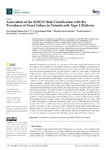Mostrar o rexistro simple do ítem
Association of the KDIGO risk classification with the prevalence of heart failure in patients with type 2 diabetes
| dc.contributor.author | Gimeno-Orna, José Antonio | |
| dc.contributor.author | Rodríguez-Padial, Luis | |
| dc.contributor.author | Anguita-Sánchez, Manuel | |
| dc.contributor.author | Barrios, Vivencio | |
| dc.contributor.author | Muñiz, Javier | |
| dc.contributor.author | Pérez, Antonio | |
| dc.date.accessioned | 2021-10-22T09:32:51Z | |
| dc.date.available | 2021-10-22T09:32:51Z | |
| dc.date.issued | 2021-10-09 | |
| dc.identifier.citation | Gimeno-Orna JA, Rodríguez-Padial L, Anguita-Sánchez M, Barrios V, Muñiz J, Pérez A. Association of the KDIGO risk classification with the prevalence of heart failure in patients with type 2 diabetes. J Clin Med. 2021 Oct 9;10(20):4634. | es_ES |
| dc.identifier.issn | 2077-0383 | |
| dc.identifier.uri | http://hdl.handle.net/2183/28707 | |
| dc.description.abstract | [Abstract] The objectives of this study were to determine the main characteristics associated with the presence of heart failure (HF) in patients with type 2 diabetes (T2DM), and specifically to assess the association of the risk classification proposed by the Kidney Disease Improving Global Outcomes (KDIGO) guidelines with HF. The DIABET-IC study is a multicentre, observational, prospective and analytical study in T2DM patients recruited in Spanish hospitals. This work, which features a cross-sectional design, has been conducted with the data obtained at the inclusion visit. The main dependent variable analysed was the presence of HF. The predictive variables evaluated were the demography, clinic, laboratory testing (including natriuretic peptides) and echocardiography. Patients were classified according to the number of vascular territories with atherosclerotic involvement and the KDIGO risk category. Multivariate logistic regression models were performed to determine the risk posed by the various baseline variables to present HF at the time of study inclusion. The study included 1517 patients from 58 hospitals, with a mean age of 67.3 (standard deviation (SD): 10) years, out of which 33% were women. The mean DM duration was 14 (SD: 11) years. The prevalence of HF was 37%. In a multivariate analysis, the independent predictors of HF were increased age (odds ratio (OR) per 1 year = 1.02; p = 0.006), decreased systolic blood pressure (OR per 1 mmHg = 0.98; p < 0.001), decreased haemoglobin (OR per 1 g/dL = 0.86; p < 0.001), the presence of obstructive sleep apnoea (OR = 1.61; p = 0.006), the absence of hepatic steatosis (OR = 0.59; p = 0.016), the severity of atherosclerotic involvement (OR 1 territory = 1.38 and OR > 1 territory = 2.39; p = 0.02 and p < 0.001 respectively) and the KDIGO risk classification (high-risk OR = 2.46 and very high-risk OR = 3.39; p < 0.001 for both). The KDIGO risk classification is useful to screen for the presence of HF in T2DM patients. Therefore, we believe that it is necessary to carry out a systematic screening for HF in the high- and very high-risk KDIGO categories. | es_ES |
| dc.description.sponsorship | This research was funded by the Spanish Society of Diabetes (SED) and the Spanish Society of Cardiology (SEC) | |
| dc.language.iso | eng | es_ES |
| dc.publisher | MDPI | es_ES |
| dc.relation.uri | https://doi.org/10.3390/jcm10204634 | es_ES |
| dc.rights | Creative Commons Attribution 4.0 International Licence (CC-BY 4.0) | es_ES |
| dc.rights.uri | http://creativecommons.org/licenses/by/4.0/ | * |
| dc.subject | Type 2 diabetes | es_ES |
| dc.subject | Cardiovascular disease | es_ES |
| dc.subject | Heart failure | es_ES |
| dc.subject | KDIGO risk category | es_ES |
| dc.title | Association of the KDIGO risk classification with the prevalence of heart failure in patients with type 2 diabetes | es_ES |
| dc.type | info:eu-repo/semantics/article | es_ES |
| dc.rights.access | info:eu-repo/semantics/openAccess | es_ES |
| UDC.journalTitle | Journal of Clinical Medicine | es_ES |
| UDC.volume | 10 | es_ES |
| UDC.issue | 20 | es_ES |
| UDC.startPage | 4634 | es_ES |
| dc.identifier.doi | 10.3390/jcm10204634 |






